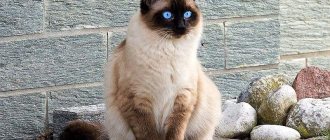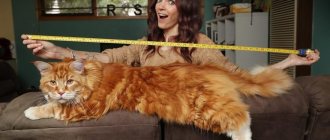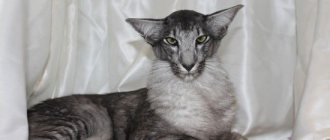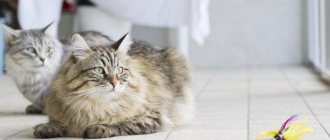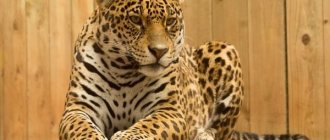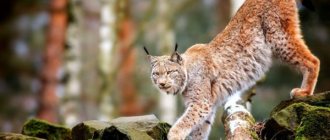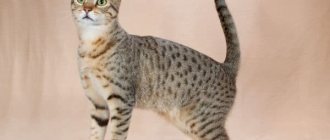What will you learn from the article?
- Cat breeds similar to Maine Coon lynx
- Kurilian Bobtail
- American Bobtail
- Siberian cat
- Norwegian Forest Cat
- Savannah
Outwardly, our furry lazy people bear little resemblance to their wild forest ancestors. This is not about the lynx-like cat breeds that will be discussed in the article. If you want to have an animal at home that is reminiscent of wild nature, you should pay attention to the following breeds.
The history of cats with tufted ears
An interesting story is about an attempt to breed a new breed from caracals, which the inhabitants of Asia have been trying to tame for a long time. Although graceful desert lynxes with tufted ears were never domesticated, they were able to cross them with ordinary large cats and even produce offspring.
The first case of the birth of such kittens was recorded by employees of the Moscow Zoo in 1998. Hybrid animals turned out to be infertile. It was later discovered that lynxes and cats have different genetic codes. Therefore, it is impossible to obtain a mixture of them without the intervention of genetic engineering.
After this discovery, experiments stopped for some time. And in 2007, German and American felinologists decided to resume work. As a result of their experiments, new hybrid kittens were born. True, this time too the crossbreed turned out to be incapable of reproducing offspring.
Maine Coon
The largest breed among domestic cats. It was developed in the USA, in Maine, but has spread throughout the world. Maine Coons are gentle giants. These cats are loved for their gentle disposition and unusual appearance, similar to a lynx: tufts on the ears, large paws, and a three-layer fur coat. In their “forest” color, Maine Coons especially resemble lynxes.
Peculiarities:
- Height up to 45 cm (body length up to 1 m), weight up to 12 kg;
- Very affectionate, perfect for families with children;
- Price from 15,000 rub.
Maine Coon
Cat breeds similar to lynx
There are now several known species of domestic cats that resemble predatory animals. The appearance of these animals is almost completely identical to the exterior of their wild counterparts. But unlike the latter, they have a calmer disposition and are easier to socialize.
Some of the most famous cat breeds that are visually similar to the lynx include:
- caracal;
- Norwegian Forest Cat;
- Maine Coon;
- pixie bob;
- American and Kurilian bobtails.
Caracal
Although caracals are classified as a separate genus, they have common roots with wild lynxes. They are mainly distributed in Africa, Central and Asia Minor, and the Middle East. Caracals are listed in the Red Book, but belong to species that are at minimal risk of extinction.
These large cats look like real lynx. They grow up to 45 cm at the withers and weigh 11-20 kg. The elongated body of the caracal is covered with short, thick hair of a sandy or red-brown hue. The animal’s paws have peculiar brushes that make it easier to move along the sand.
The caracal's ears are decorated with fluffy black tassels, thanks to which it received its second name - steppe lynx.
The domesticated predator is very affectionate with its owners. But if the cat decides that he was unfairly offended, he will defend his interests. Even after taming, this mini-lynx has the habits of a wild animal. Therefore, it is better not to leave her alone with children, strangers and other animals.
It is advisable to keep a lynx-like cat in a well-equipped enclosure with the possibility of free walking around the yard.
Norwegian Forest Cat
Experts to this day have not reached a consensus regarding the origin of these animals. Some believe that the ancestors of the cat, which looks like a lynx, were wild angoras brought to the Norwegian forests by the Vikings. Others are convinced that Pallas' cat blood flows in his veins.
Norwegian Forest cats are large cats, weighing up to 7 kg. Tassels on the ears, strong bones and developed muscles make them look like a lynx. The animal's body is covered with thick, waterproof fur of any color.
Although the Norwegian Forest looks like a real lynx, it is endowed with a playful disposition and knows how to get along with children of all ages. Cats of this breed are distinguished by extraordinary mental abilities and developed hunting instincts.
Maine Coon
This breed of cats, similar to a lynx, was formed as a result of natural crossing of large individuals. Although the appearance of the Maine Coon is close to that of wild predators, there is no close relationship between them. And its name, literally translated, sounds like “raccoon from Maine.”
The Maine Coon is a large cat whose weight can reach 12 kg. The muscular, stretched body of the animal is covered with semi-long hair, forming a collar on the neck and pants. The color can be any, with the exception of lilac, chocolate, beige, color point and cinnamon.
The outline of the head and the shaggy tufts on the tips of the ears give the cats of this breed a resemblance to a lynx.
Maine Coons are distinguished by their outstanding intellectual abilities and affectionate, easy-going disposition. Large cats, similar to lynxes, are extremely active, playful and sociable. They are especially affectionate towards their owners and get along well with different pets.
Pixie bob
This American breed is descended from a large short-tailed outdoor cat and a tailless polydactyly cat. The kittens born as a result of this mating had an unusual appearance. Among them, a spotted female, similar to a lynx, especially stood out. It was with her that the history of the breed began, which is called the pixie-bob, which translates as “short-tailed elf.”
These massive cats have strong bones and well-developed muscles. The weight of a pixie bob reaches 5-9 kg, and its main distinguishing feature is polydactyly. The short tail, spotted colors and tufts on the ears give the cat of this breed a special resemblance to a lynx.
Pixie beans are phlegmatic animals with developed intelligence and good immunity. They quickly get used to their owners and need close contact with people. These cats easily learn commands and do not refuse to walk on a leash.
Despite their predatory appearance, representatives of the breed are patient with children of different ages and get along well with other pets.
American and Kurilian bobtails
These breeds were developed at the end of the 20th century. The ancestors of the American bobtail are considered to be the common domestic cat and the Indian short-tailed cat. Representatives of the breed weigh up to 8 kg and have many color options. Americans become very attached to their owners and walk with a slightly balancing gait.
Read more about the American Bobtail.
Kurilian Bobtails are descended from Siberians and Japanese temple cats. Externally, representatives of the breed resemble predators. A short tail and shaggy ear tufts enhance the resemblance to a lynx. Kurilian Bobtails have developed hunting instincts. Therefore, birds, small rodents and squirrels often become easy prey for these cats.
Read more about the Kurilian Bobtail.
Lynx-like cat - American Bobtail
A lynx-like cat - Kurilian Bobtail
Wild lynxes that can be kept in enclosures
Bobcat (bobcat)
A red lynx from North America may well become a pet, provided that it is adopted as a kitten from a nursery, is socialized under the supervision of a specialist, and is constantly in contact with its owner. But in adulthood, alas, the pet will have to be moved into a spacious enclosure and contact will only be made on days when the pet is especially affectionate towards you.
The level of domestication of the bobcat is much lower than that of the caracal, so there is no need to talk about complete domestication. The high price for a kitten is accompanied by the expensive maintenance of a cat, so the red lynx has not become widespread. Although connoisseurs of unusual domestic animals can purchase a bobcat as a domestic cat and enjoy its semi-wild company.
IMPORTANT: all other types of lynx are considered completely unsuitable for keeping as pets.
Hybrids
Those who want to place a real predator in their home are better off not taking risks and choosing an alternative in the form of a mestizo. The first generation hybrid is visually almost no different from its wild ancestors, but has a softer disposition.
Representatives of the cat family that have retained their primitive appearance include:
- caraquet;
- domestic lynx.
Caraquet
The ancestor of this lynx-like breed was a caracal crossed with a Bengal cat. Caraquetas are not small animals, whose weight can reach 15 kg. Like their predatory ancestor, they have long hind legs and tufted ears. And their spotted coat only enhances their resemblance to a lynx.
Caracats are calm, peace-loving cats. Although the animals look like a predator, they are endowed with a playful disposition. Representatives of the breed get along well in the same territory with other pets.
You can learn more about the breed from the article “Caraquet cat”.
This lynx-like hybrid variety quickly learns to walk on a leash and needs a designated area to exercise its hunting instincts.
Domestic lynx
These animals appeared as a result of crossing ordinary cats with Canadian lynxes. They have a “wild” exterior and a gentle character. From the Canadian lynx, they inherited the “trademark” tufts on their ears, almond-shaped eyes, a gracefully arching back, long hind limbs and a short tail. They have a blue-gray or gray-brown coat.
The domestic lynx needs careful grooming and extra attention. She should be able to exercise a lot and eat raw meat.
Caring for domestic lynx and caraquet
It is worth understanding that the blood of wild predators flows in the veins of these cats, so feeding your pet with dry commercial food is unacceptable. Animals require fresh meat in large quantities, as well as bones and sinews in order to give load to their developed jaws. The diet of a domestic lynx should be balanced. The high physical activity of pets should also find a way out - preferably living in a spacious dwelling or enclosure.
To prevent hair ingestion, it is worthwhile to carry out regular brushing and periodically give animals a product to prevent the accumulation of hairballs in the gastrointestinal tract. Bathing, active games, and walks should also become part of caring for an exotic animal.
Pet character
Lynx-like cats are endowed with a friendly and flexible disposition. Many of them have high intelligence and easily remember different commands. The good-natured nature of lynx cats allows them to get along with different pets without problems.
They require care and attention no less than representatives of breeds that have a “dwarf” size. But unlike them, they can protect themselves from the danger that threatens them.
Lynx-like cats attract everyone's attention with their spectacular appearance and gentle character. True, due to difficulties with reproducing offspring and the high cost of kittens, these breeds are not very common not only in Russia, but also abroad.
Table: pros and cons of the Caraquet breed
| pros | Minuses |
|
|
Distinctive features of animals
The domestication of the cat, according to historians, happened about nine and a half thousand years ago. But due to the preservation of hunter instincts, independent disposition, and a relatively easy ability to adapt to the wild, many scientists consider domestic cats to still be half wild animals.
Although each “mini-lynx” is unique in origin, care, has a different character and requires different types of care, there are special characteristics that unite them, distinguishing them from ordinary domestic cats:
- large size and developed muscles;
- strong paws and stocky body;
- almond-shaped and expressive large eyes;
- hair of different lengths in different parts of the body;
- thick mustache;
- tassels and fur on the ears (not all breeds).
Breeding secrets
What distinguishes a breeder from an ordinary cat owner is, first of all, the knowledge necessary for the birth of healthy, strong offspring. The breeder’s goal, in turn, is not to breed more kittens and sell them profitably, but to breed kittens that are superior to their parents in beauty, health, and compliance with breed standards. To achieve results, the breeder becomes a specialist in veterinary medicine, genetics, studies the characteristics of the breed, is aware of new developments in this area, and also purchases new cats, monitors nurseries around the world, runs his own breeding program, constantly monitors the health of animals, conducts DNA -tests exclude individuals with genetic diseases.
Maine Coon kittens
And if an owner gets a pair of animals of different sexes, wanting to provide them with a happy personal life, in most cases this, unfortunately, indicates carelessness and irresponsibility. Not to mention the fact that conditions are necessary for the offspring and their parents, you need to start with the fact that it is not easy to even find two healthy animals; professional breeders simply will not sell such animals. And buying a cat from an untrustworthy seller almost always leads to diseases, most often genetic, resulting in death and non-viability of kittens. And this especially applies to purebred cats.
It is impossible to provide a cat’s privacy with the help of a single female cat; they will have to be separated during estrus, otherwise constant pregnancies will cause exhaustion of the body.
Therefore, it is difficult to call only the acquisition of animals of different sexes a desire for breeding. Only after acquiring knowledge, providing the conditions, weighing all the factors, and finding potential owners in advance, can you think about the possibility of such an activity.
Content
Maine coons in an enclosure
If you decide to get a cat that looks like a lynx, you will need a thorough approach. Consult with breeders, read the recommendations on thematic forums before you adopt a kitten.
Depending on the needs of animals and the degree of their adaptation to living conditions in the house, the conditions created for their maintenance change. Chausie, Caracat, Maine Coon, and domestic lynx are very mobile, so they need a lot of space. Cats also require special care and feeding that meets high standards. All these points are quite financially expensive, so desire alone is not enough to keep such animals.
More domesticated cats, which resemble wild ones, are smaller in size and the requirements for living conditions are less stringent. This category includes the Siberian, Norwegian forest cat, Kuril and American bobtails, and pixie-bob. There is no need for them to have an equipped enclosure; it is enough to arrange a place in the apartment where they can give free rein to their activity. Constant and careful care is also necessary for them.
Failure to comply with maintenance rules threatens to deteriorate the health of cats.
